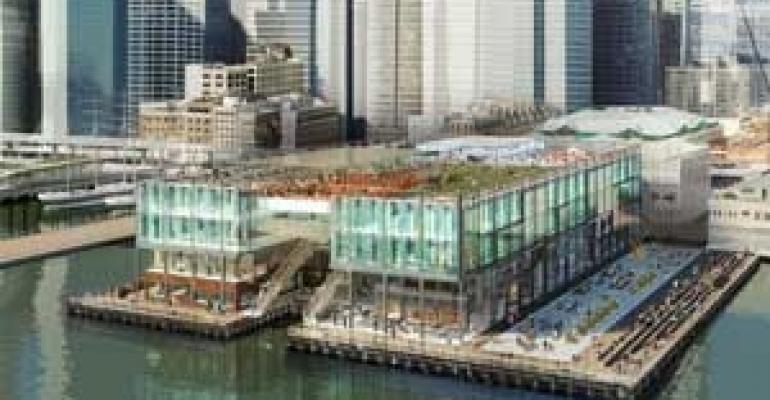The Howard Hughes Corp. unveiled its first project as an independent company this week and it seems to be off to an impressive start with a development plan that has become a smash hit in one of the toughest markets in the country: New York City.
The project involves the redevelopment of the South Street Seaport in downtown Manhattan, a retail venue that boasts great demographics and enviable waterfront views, but which has been largely ignored by local residents because of its unimaginative design and merchandising mix, according to Jeffrey D. Roseman, New York-based executive vice president and principal with Newmark Knight Frank Retail.

General Growth Properties (GGP), the Seaport’s previous owner, considered an overhaul of the property in 2008 which would have included demolishing the existing structure and replacing it with a mixed-use complex featuring a 500-unit hotel and condominium tower, in addition to retail space. New York’s Landmarks Preservation Committee, however, disapproved of the plan because the scale of the project did not fit with the size of existing buildings in the area.
The plans presented by the Howard Hughes Corp., a spin-off of GGP that focuses on mixed-use projects and development opportunities, would keep the Seaport’s current scale largely intact, adding only 20,000 sq. ft., but would replace the existing enclosed structure with one made largely of glass and steel. The project would feature an open-air rooftop garden and would aim to secure LEED Silver certification. Its glass doors would be kept open in the summer but come down in the fall and winter months to keep out cold air. New York-based SHoP Architects came up with the new design for the property.
“The company’s vision for the renovated Pier 17 building at the South Street Seaport balances the pier’s iconic waterfront location with its unique ability to provide a much needed community anchor for the rapidly growing residential population in Lower Manhattan,” said Chris Curry, Howard Hughes’ senior executive vice president of development, in a statement. “We look forward to a conversation with the community that demonstrates our commitment to create an unparalleled New York experience that is compelling to residents, local workers and tourists alike.”
Howard Hughes officials still have to present the new design to the Landmarks Preservation Committee. Preliminary plans call for construction to start in 2013, with completion scheduled for 2015.
New York retail brokers say the plan has the potential to completely revitalize the property with a design that takes advantage of the Seaport’s great location and a new merchandising mix that would serve as a draw for local residents and office workers as well as tourists.
“What the Howard Hughes Corp. is proposing is plainly based on everything that’s happening downtown,” says Robin Abrams, principal and executive vice president with The Lansco Corp., a New York City-based real estate services firm. “I think it’s brilliant because certainly from a design point of view it takes advantage of the location and creates something that’s really exciting and vibrant.”
“In particular, if you look at the Pier 17 building, it’s kind of a box. This new plan has so much air and light and takes advantage of people being able to go inside and outside and see views of the water. Before, you went inside and you were in a mall.”
Existing framework
Today the South Street Seaport encompasses 285,000 sq. ft. of space located in several buildings, including the structure at Pier 17 and 210 Front Street. Current tenants at the property include, among others, Abercrombie & Fitch, Ann Taylor, J. Crew, GameStop, Sunglass Hut, The Body Shop and Bath & Body Works, as well as a collection of restaurants. The problem is that many of these retailers can be found in multiple locations throughout the city, says Roseman.
The Seaport was originally completed in 1983 and over the past 10 years, it’s “gotten very tired, and it really has not been maintained well,” he notes. “To build a typical mall there with the same tenants won’t cut it. To me, the key to [revitalizing the place] will be restaurants and entertainment because that’s what draws people down there.”
Back in the 1980s, the South Street Seaport was in fact the primary retail destination in lower Manhattan, according to Gene Spiegelman, New York-based director in the retail services division of Cushman & Wakefield. Now, with the projects going on at the World Financial Center, the World Trade Center and the Fulton Street Transportation Terminal, it can once again regain its prominence.
Claritas Inc. forecasts that by 2015, Lower Manhattan will be home to 85,000 residents and 441,000 office workers. Average household income in the area is already $242,000, more than double the New York City average of $75,198.
For now, both Abrams and Roseman says that with the new plan, Howard Hughes executives have shown a fundamental understanding of what makes a mixed-use development work. What’s more, they are building on the legacies of their predecessor companies, according to Spiegelman, including Rouse, which developed the South Street Seaport and invented the concept of festival marketplaces, and the original Howard Hughes Corp.
“They are obviously experienced and the best thing, I think, is they have the correct vision for what needs to be down there, it’s definitely not the ‘same old,’” says Roseman. “They are not looking to just build a mall here and my gut tells me they will be able to get it done.”

